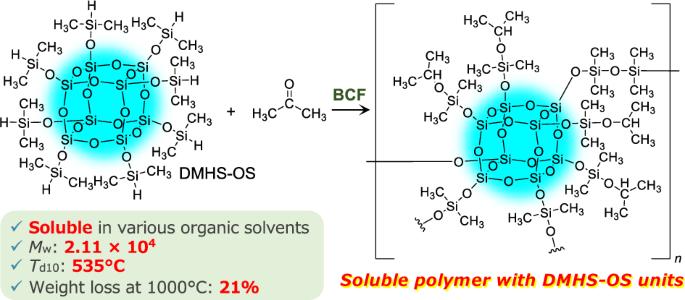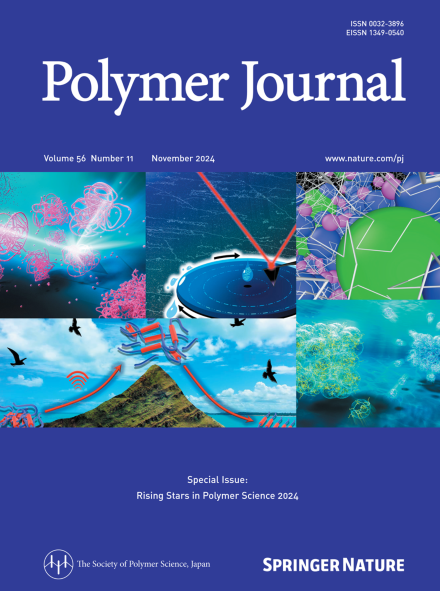Thermally stable soluble polymers prepared via the tris(pentafluorophenyl)borane-catalyzed polymerization of hydrosilyl-functionalized cage octasiloxane
IF 2.7
4区 化学
Q3 POLYMER SCIENCE
引用次数: 0
Abstract
In this study, we successfully prepared soluble polymers via the tris(pentafluorophenyl)borane (BCF)-catalyzed hydrosilylation of dimethylhydrosilyl-functionalized cage octasiloxane (DMHS-OS) and acetone, followed by dehydrocarbon condensation polymerization (Piers–Rubinstzajn reaction) between the unreacted hydrosilyl (Si–H) groups and converted isopropoxysilyl (Si–OiPr) groups of DMHS-OS. Notably, polymer Poly(DMHS-OS)-5, formed at a feed molar ratio of Si–H groups to acetone of 8:5, exhibited a relatively high weight-average molecular weight (Mw = 2.11 × 104). On the basis of the 1H NMR, 29Si NMR, and gel permeation chromatography results, Poly(DMHS-OS)-5 consists of approximately 17–18 linked cage octasiloxane repeating units. Despite the presence of alkoxysilyl groups, such as Si–OiPr, in the side chains, immersion in purified water for 1 h did not affect the solubility of the polymer, indicating its good water stability. Thermogravimetric analysis revealed that the 10% weight loss temperature of Poly(DMHS-OS)-5 was 535 °C and only 21% weight loss occurred at 1000 °C, indicating exceptionally low thermal degradation. These findings highlight the remarkably high thermal stability of the soluble polymer Poly(DMHS-OS)-5. Soluble polymers were prepared by polymerizing dimethylhydrosilyl-functionalized cage octasiloxane (DMHS-OS) using a tris(pentafluorophenyl)borane (BCF) catalyst through hydrosilylation with acetone, followed by dehydrocarbon condensation. Poly(DMHS-OS)-5, formed at a feed molar ratio of Si–H groups in DMHS-OS to acetone of 8:5, exhibited a weight-average molecular weight (Mw) of 2.11 × 104 and consisted of ca. 17–18 linked DMHS-OS units. It demonstrated high thermal stability, with a 10% weight loss temperature (Td10) of 535 °C and a weight loss of only 21% at 1000 °C.

三(五氟苯基)硼烷催化氢硅官能化笼型辛硅氧烷聚合制备热稳定的可溶性聚合物
在本研究中,我们通过三(五氟苯)硼烷(BCF)催化二甲氢硅基功能化笼型八硅氧烷(DMHS-OS)与丙酮的硅氢化反应成功制备了可溶性聚合物,然后在未反应的硅氢基(Si-H)与DMHS-OS转化的异丙氧基(Si-OiPr)之间进行脱烃缩聚(Piers-Rubinstzajn反应)。值得注意的是,在Si-H基团与丙酮的进料摩尔比为8:5时形成的聚合物Poly(DMHS-OS)-5表现出相对较高的重量-平均分子量(Mw = 2.11 × 104)。根据1H NMR, 29Si NMR和凝胶渗透色谱的结果,Poly(DMHS-OS)-5由大约17-18个连接的笼型辛硅氧烷重复单元组成。尽管侧链中存在烷氧基硅基,如Si-OiPr,但在纯净水中浸泡1小时不影响聚合物的溶解度,表明其具有良好的水稳定性。热重分析表明,Poly(DMHS-OS)-5的10%失重温度为535℃,在1000℃时仅发生21%的失重,表明其热降解非常低。这些发现突出了可溶聚合物Poly(DMHS-OS)-5的高热稳定性。以三(五氟苯)硼烷(BCF)为催化剂,经丙酮硅氢化反应,脱烃缩合,制备了二甲基氢硅基功能化笼型八硅氧烷(DMHS-OS)的可溶聚合物。Poly(DMHS-OS)-5在DMHS-OS中Si-H基团与丙酮的进料摩尔比为8:5时形成,其重量平均分子量(Mw)为2.11 × 104,由大约17-18个DMHS-OS单元组成。它表现出很高的热稳定性,535℃时失重10% (Td10), 1000℃时失重仅21%。
本文章由计算机程序翻译,如有差异,请以英文原文为准。
求助全文
约1分钟内获得全文
求助全文
来源期刊

Polymer Journal
化学-高分子科学
CiteScore
5.60
自引率
7.10%
发文量
131
审稿时长
2.5 months
期刊介绍:
Polymer Journal promotes research from all aspects of polymer science from anywhere in the world and aims to provide an integrated platform for scientific communication that assists the advancement of polymer science and related fields. The journal publishes Original Articles, Notes, Short Communications and Reviews.
Subject areas and topics of particular interest within the journal''s scope include, but are not limited to, those listed below:
Polymer synthesis and reactions
Polymer structures
Physical properties of polymers
Polymer surface and interfaces
Functional polymers
Supramolecular polymers
Self-assembled materials
Biopolymers and bio-related polymer materials
Polymer engineering.
 求助内容:
求助内容: 应助结果提醒方式:
应助结果提醒方式:


